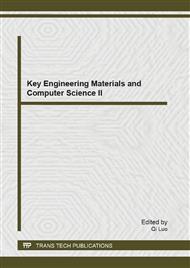p.3
p.9
p.15
p.21
p.27
p.33
p.37
p.44
p.49
Phase Structure, Microstructure and Electrical Properties of BiMnO3-Doped (Na0.515K0.485)0.96Li0.04(Nb0.8Ta0.2)O3 Lead-Free Ceramics
Abstract:
1-x)[(Na0.515K0.485)0.96Li0.04(Nb0.8Ta0.2)O3]-xBiMnO3 (x = 0, 0.002, 0.004, 0.006, 0.008 and 0.010) lead-free ceramics were prepared using a conventional mixed-oxide method. The result indicated that the highest density of 4.89 ± 0.01 g/cm3 was found in 0.6 mol% BiMnO3 - doped sample sintered at 1060 C. Grain size decreased with increasing of BiMnO3 content. In the composition range studied, the perovskite phase with the coexistence of the orthorhombic and tetragonal phases was identified at approximately 0 x 0.006 by the X-ray diffraction analysis, which led to a significant enhancement of the piezoelectric properties. The temperature dependence of dielectric properties showed that the addition of BiMnO3 markedly decreased the ferroelectric tetragonal-paraelectric cubic phase transition temperature (TC), and greatly shifted the polymorphic phase transition from the ferroelectric orthorhombic to the ferroelectric tetragonal phase (TOT) to near room temperature. Sample with x = 0.002 exhibited excellent electrical properties: the dielectric constant (εr) = 1228, dissipation factor (tan δ) = 0.0244, piezoelectric constant (d33) = 235 pC/N, and Curie temperature (TC) = 286 °C. These results clearly showed that the 0.998(Na0.515K0.485)0.96Li0.04(Nb0.8Ta0.2)O3 - 0.002BiMnO3 ceramics are very promising lead-free piezoelectric candidates.
Info:
Periodical:
Pages:
27-32
Citation:
Online since:
July 2013
Authors:
Keywords:
Price:
Сopyright:
© 2013 Trans Tech Publications Ltd. All Rights Reserved
Share:
Citation:


